
|
||
|
Portland art blog + news + exhibition reviews + galleries + contemporary northwest art
|
||
Taking Full Stock of the Portland art scene, Part I "The goal of our intellectual efforts cannot be a static, polished possession...In our many efforts toward knowledge, science, math, logic as in life itself, it is the process, not the terminus, that should concern us - if we are wise." Bruce Aune Rationalism, Empiricism, and Pragmatism The fall season is in full swing, I've been here a little over a decade now and PORT is heading towards its 5th anniversary, so it seems like an opportune time to take full stock of the development of the Portland art scene. Part I is general and interrelated (nine ways to improve, Portland as a model city, and our recent past). Part II will be more specific, discussing artists - young, mid-career and old - different types of institutions, etc. 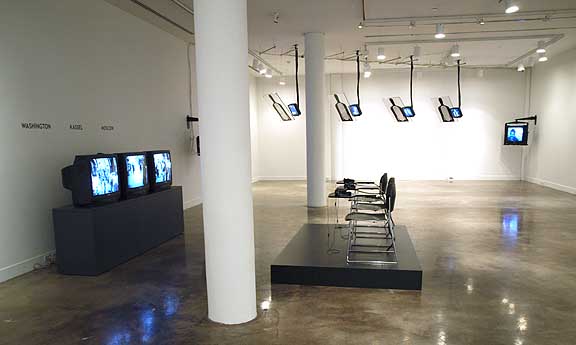 Broadcast at Lewis and Clark College (Dara Birnbaum's Hostage, 1994, in background) 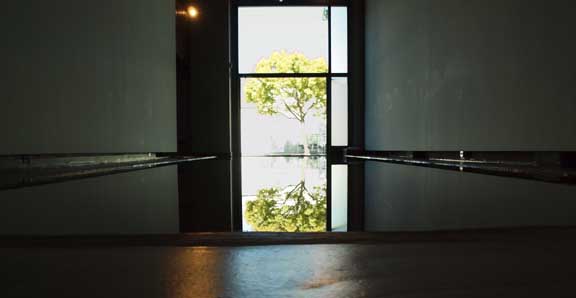 Rose McCormick's Grande Ronde concluded NAAU's Couture series last weekend There have been many excellent shows this season so far, including Rose McCormick's Grand Ronde, Broadcast at Lewis & Clark, Tom Cramer at Laura Russo, Jesse Hayward & Ethan Rose at TBA, Jordan Tull at Littlefield, Vanessa Renwick at Blue Sky, Ryan Pierce at Elizabeth Leach, and Processions at PSU, plus China Design Now and Raphael's Valeta at the Portland Art Museum. Portland definitely has a strong scene by anyone's standards, but it's not without its challenges. Only recently have our two top visual arts institutions (PAM and PNCA) embarked on serious campaigns with major donor education components. With PNCA celebrating its centennial this month, it's important to remember that they were the same entity a mere decade and a half ago and that only recently have the two organizations concentrated heavily on endowments and legacy gifts. The situation reminds me of the odd and sometimes beautiful combination of youth and age I come across in Portland. Now we seem to be at a tipping point where Portland could be more than just a great place for artists and become a better place for art. It's a subtle distinction that everyone should be considering. 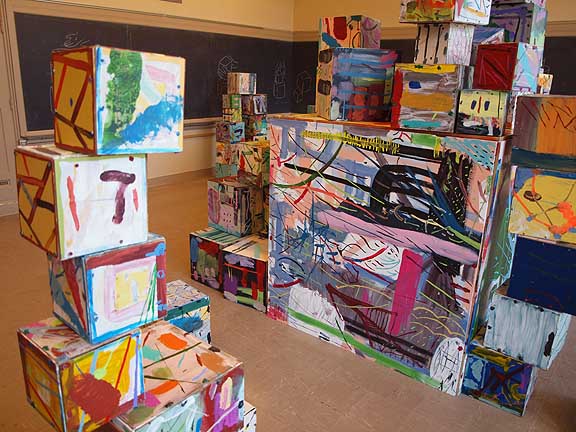 Jesse Hayward at TBA (this year was the best visual arts offering in the event's 5 year history) 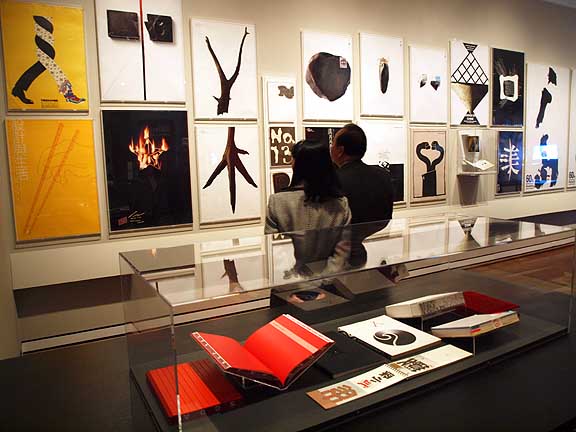 China Design Now posters Consider the past decade: On the one hand, Portland's art community has vastly improved, with fantastic "catch up" growth in the Museum, improvement in the art schools, a growing number of visiting international artists, increasing quality of artists, more alt spaces, etc. I'd say we are five times more serious in every category than we were five years ago in 2004, and even back then things were humming. Yet, to "tell the hardest truth first," the greatest danger to Portland's progression from being a city that enjoys a human scale and arty quirks to one that leads in art, design, livability and progressive ideas is a sometimes self-satisfied complacency that blunts analysis and action. In other words, we need to take responsibility for excellence rather than just accepting the greatly improved, but not exactly leading edge (in all areas), status quo. Individual artists may be great, but as yet no art institution or gallery in Portland has met that standard. (I am exceptionally tough - in my opinion, the only "Great" art museum on the west coast is SFMOMA, although MOCA could be if they had some place to display their permanent collection. The west coast has more great art schools than it has great museums. It's irksome, but it also puts greater pressure on the museums to be relevant, which is why MOCA is so important). Leadership and relevance are our challenges in Portland. We accomplish "good" or "OK" projects (like esplanade, the Contemporary Northwest art Awards, etc.) and collectively the art/design scene has achieved some greatness. However, we need to occasionally push to create "Great" institutions and projects that are icons for the rest of the world, showing that Portland has a leading edge (we did this with the aerial tram, so it isn't impossible). Right now our greatness is mostly confined to an ever growing list of artists, musicians, restaurants, and overall livability. Thus, there is a still a divide between the artistic community and patrons and institutions, which must support the community to truly brand's Portland as a "Model City" of livability and culture. We seem to have found our ambition. But where are the plans (OCAC and PNCA do have building plans and PAM is raising endowment dollars), and are the plans we have ambitious enough in all sectors? We need to take a stand in ways that give Portland greater credit for the hard work we've already put in. That means confident gestures like the tram, but more directly helpful for artists. The lack is partly due to the fact that this is a city of individual citizens and small businesses, not corporations, which means that wealth is less concentrated, although the money is still here - for example Portland has 2-3 billionaires. That diffusion also means that accountability and responsibility are sometimes limited to an individual's prerogative (patrons, artists, etc) and the links between patron and artist often aren't as formalized through awards and critical familiarity as they are in most cities, even ones with much less bustling art scenes. For example, I bet most artists couldn't name the top collectors are in town. (A good list might include Ed Cauduro, Bonnie Serkin, Paige Powell, Jordan Schnitzer, Gordon Sondland, and Sarah Meigs. There are younger ones too, many of whom are real estate developers.) Maybe Portland is finally at an age where it's ready to take responsibility for knowing what the score is so it can plan. In that process maybe we can try to hit a few out of the park, or go for an ace, or... etc. Pick any bad sports metaphor, they all mean one thing: Undeniable excellence that comes off as a clear winner. To take the Portland art scene to the next level I'd like to see more responsibility taken in these areas: 1) A more civic-wide responsibility to perform greater analysis (criticism), and general knowledge of what the score is, which will help everyone set their expectations. For critics, that means reviews should be primarily about the work, taking a more serious approach rather than the odd intra-scene art-political analysis or persona piece that ultimately says very little because art politics mean little short of judgment calls about someone's ability). On an individual level; we can let our friends know what we really think (mine certainly do - they wont shut up). On a more civic level, the city's governing and business leaders need to know who is who and how they can help the talented artists. To accomplish that, civic leaders need to be able to trust what is published about art. Overall, analysis means taking stock of areas that need work. In Portland that means financial support of the numerous alt spaces and individual artists, further steps to make PAM more world class (such as a devoted Rothko exhibition space, with revolving loans from the NGA & Rothko Foundation, Tyler Green's idea) and an as yet unrealized Art Center with an experimental world class exhibition program that doesn't collect art (I'll discuss this further later in this piece). And how we will pay for this? What about a coffee tax? Or a levy on hotel rooms, since travel magazines continually tout Portland's arts? How about a publicly spearheaded but mostly private development partnership like San Francisco's Yerba Buena as a model for an adequate art center, one with a budget of 1 million a year, and professional staff? (Anything else is an alt space.) 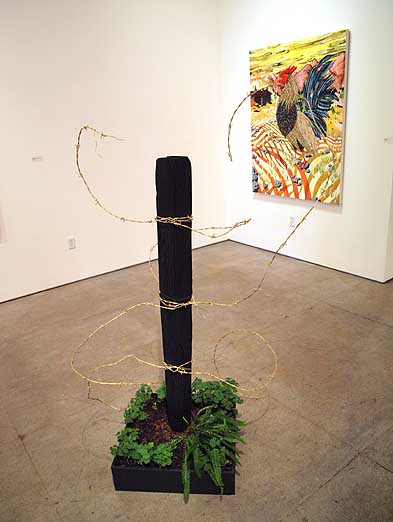
Ryan Pierce at Elizabeth Leach found a way to make a painting show more than just a painting show with live plants (photo Jahn) 2) Artists, curators, and gallerists should take more responsibility for exhibition excellence. This means creating an identity through a progression of shows. Too many Portland exhibitions (from the museum to galleries to warehouse shows) are anonymously stuffed way too full of work, and too many curators curate the same show over and over again. Excellent shows stand out and let the work stand out by not being cluttered. How about few 3 person shows instead of 20 people? Other times the concept just isn't developed enough. My advice for artists is, don't over show and try to make each exhibition count, rather than continually saturating the art scene. Overall, programmatic responsibility means asking, is this really what we need to show right now and how can it best be exhibited? Also, minor improvements to spaces equals big improvements to exhibition quality, yet there is no funding engine for these improvements to smaller alt spaces (most funding sources are for 501-C3s). Luckily, Portlanders now know the difference between simply letting artists run amok in a space and a well-curated exhibition. This was not the case in 2003 when things really woke up with a series of giant warehouse shows, including Beamsplitters, I.A.E., The Best Coast, The Modern Zoo, Core Sample, and The Battle of the Artist Curators. Since that time, similar large group shows have been still necessary to point out new talent, but solo and one to three person shows have become the main event. NAAU's Couture series has been the most high profile exemplar in this trend, but the shift from Oregon Biennial to CNAAs is also in this vein. 3) Artists have a responsibility to their time and place. Sometimes that means doing something very counter-intuitive and not just giving people what they expect, such as the usual spectacular and entertaining shows. Art isn't just a diversion; it can be central to the civic discussion in this city by taking a unique point of view on things that we all take for granted. Likewise, a gallerist or curator has a responsibility to their time. In Portland, Rock's Box and NAAU's Couture series have been better at fulfilling this role than other spaces because they have a clear, strong programmatic focus. The programming is clearly being executed from a specific point of view, and that's why they're probably the two tightest spaces in town, but it doesn't mean those spaces will stay that way. I'd like to see stronger show to show programming and continued leadership from Rock's Box and NAAU. Because NAAU is a commercial gallery, one has to ask if Ruth Ann Brown is about to become a model gallerist? Model gallerists such as Stieglitz, Castelli, and Paula Cooper take wild chances and represent difficult but unique work. Unlike most Portland dealers, Brown isn't pragmatic. Sometimes she stands up and, unlike any other space in town, makes iconic gestures, like her series of group shows followed by the Couture series. The question is, now that she's so established, how will she become better? Can she take the next step and place artists on the national level as Elizabeth Leach, PDX Contemporary, and Charles Hartman have done with MK Guth, Storm Tharp and Corey Arnold? "Art" is largely a game of individual achievement. If the individuals don't seek to achieve with a certain amount of rigor, then they make a poor case for themselves. 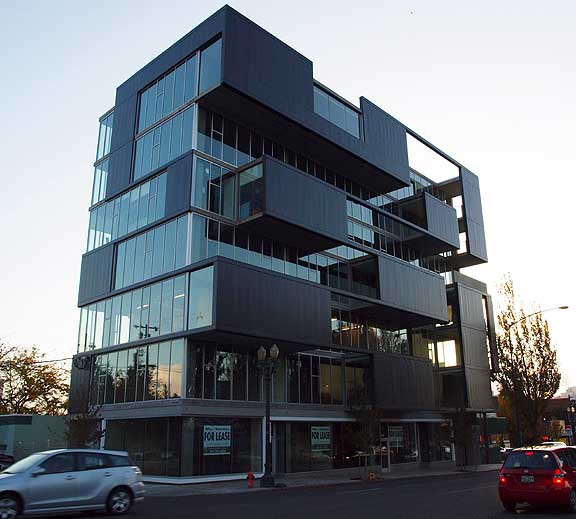 Bside6 building, a definite design shift for architecture in Portland 4) We have a responsibility to take risks in design and exhibitions. This has gotten better, but there is always more room for improvement. Too often art shows follow standardized methodologies. A little more experimentation can't hurt. Shows about portraits, landscapes, psychedelia, or ecology are a dime a dozen here. Instead, let's try to develop our ideas more so they're differentiated, and design shows so they unfold in a novel way. In Portland's once-staid architectural scene, recent condo design had started to get more interesting before the market crash, but there is still a generally low key attitude. The Bside6 and Holst's Ziba design world headquarters are important shifts for the city. We need more. The biggest design bugaboo right now is the Columbia River Crossing, which just doesn't have the world class minds and designers that a project that complicated requires. It does look like the new Willamette Transit Bridge is attracting some progressive thinking, however. 5) Patrons have the responsibility to demand more from non profits, such as asking them how they're improving and getting more serious in their programs. Likewise, those institutions should ask those patrons to step up when they need support. I'd like to see a few patrons buy warehouses so they can collect installation art. Portland's scene isn't dominated by any genre, but installation and video art are easily two of the strongest and most popular mediums, and besides Bonnie Serkin and Sarah Meigs I don't know of any other collectors who have collected installations. 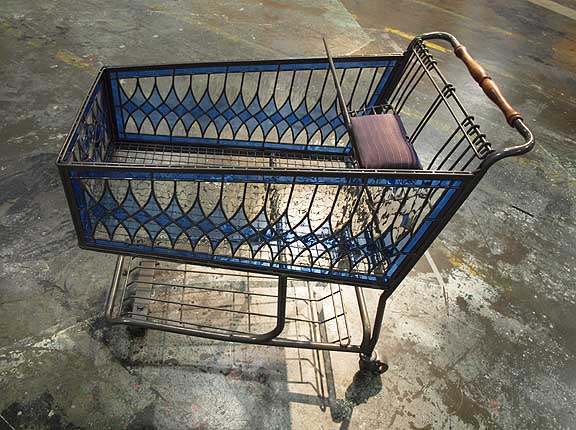 Crystal Shenk's Have and Have Not, 2006, from PNCA Faculty Biennial 6) The city of Portland should take more responsibility for elevating talent rather than downplaying it. The only reason cities exist is to put resources and people in close proximity to one another so they can elevate or support the talented, with multiple ways of defining talent. Portland has become much better at this, but we're still only halfway there - in fact other cities are often better at shining the spotlight on Portland's talent. That needs fixing. (PORT does what it can.) 7) Follow through is also very important. As we saw with Couture, series have a multiplying effect. The same goes for OCAC and PNCA, who have long term campus improvement plans. 8) Artists have to take more responsibility for continually improving. In Portland, you can't just be better than the work in Seattle or Boise and expect to go anywhere. You must put pressure on yourself to be the best out there - period. Look at artists who share similar concerns and determine if they have already eaten your lunch. If not, figure out how to distill what makes you different, then ask for studio visits from friends, critics, and curators. Somewhat established artists need to go the extra mile, not over-commit to too many shows, and make each show count. Try writing and curating too. I'm generally disappointed with the level at which even international art stars are achieving these days. People like Luc Tuymans and Urs Fischer seem more gimicky than good. I'll take Gerhard Richter or Charles Ray and Lynda Benglis over those two any day. Though artists like Inigo Manglano-Ovalle and Roger Hiorn seem to set themselves apart from the pack. 9)Last week it was announced that Portland city council no longer believes livability alone will create jobs. This is important as Portland needs to be actively recruiting progressive businesses to the city. With a few more large scale employers it would dramatically improve fundraising outlook for local nonprofits. As it stands a nonprofit, OHSU, is Portland's largest employer. That probably needs to change. The long and short of it is, Portland often falters by not giving credit where it is due (institutional shows, awards, and critical attention to the deserving), while our greatest strengths come from the continuing influx of very talented and connected individuals and the openness the entire community offers as a form of artistic license. Portland is permissive of talent and is successful in spite of itself because there isn't a lot of barbed wire (a boomtown phenomenon). Portland just doesn't always properly acknowledge talent's true value in meaningful ways that could give the artists and the city maximum traction. This traction would allow things to build, slowly but surely. For example, a non-profit space like Blue sky would (ideally) become a presenting photo museum (not a collecting one). The overall cultural ecology has improved dramatically and most similarly sized cities have this problem with acknowledging excellence. Still, some similar-sized cities do this very well and we shouldn't use size as a cop out, instead we should be realistic and pragmatic about the problem. Some have trouble calling for even more excellence, they'd rather let sleeping dogs lie. I'd counter that attitude with the assertion that "Excellence is the ideal citizen." Portland may be the seat of America's 21st century conscience (communal, green, and not asserting the corporate good above the individual), but if so, that conscience needs to assert itself more fully in design, critical awareness, and civic intention. Portland needs to acknowledge itself as a model city and Portland's art scene needs to be more conscious of being a model, which brings me to the rest of this essay. 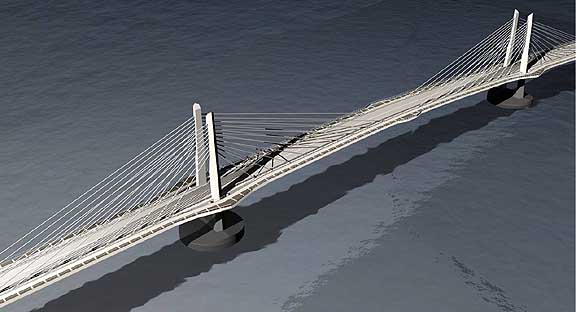 A design for the new transit, pedestrian and cycling bridge, a first in the US Portland as a Model City? In one area Portland does have a model art scene. Like very few places, in Portland if you are very good you will be noticed. Portlanders are generally supportive and well-educated, if sometimes willfully low key. The scene here is a working meritocracy, not a series of entitlements driven by parents, schools, etc. There is money in Portland, but it doesn't ruin things and the civic body is slowly becoming more adventurous (the pace causes frustration in leading edge artists, but frustration of this sort generally leads to something in the long run). The nice thing is nobody really cares how much $$$ you do or don't have. Even small towns typically have trouble in that department, but not Portland which is a medium sized city of 2.1 million metro. In character, Portland is still as it was a decade ago: A rebel base for artists. Only now we have more cultural infrastructure (though it's still underdeveloped), more artists, more urban condo dwellers, and a decade or two of momentum. Some people make money here, but it's a better strategy to travel and use Portland as a base. From time to time, I see art here that is simply better than anything similar elsewhere. This is necessarily rare and the rest of the globe is hardly experiencing a golden age. The fact remains that some of the best are here, but we don't have an attitude about it. Other nearby cities have strange, unwarranted inferiority complexes because an odd cocktail of "look at me" money and conservatism born of self-consciousness get in their way, leaving individuals feeling somewhat disenfranchised. In those places there is a preference for slickness as a hedge against not being taken seriously, but that's not Portland. The sense here is that artists are taking chances and are excited about their work (but they could always take more). Some major financial centers like San Francisco or New York are victims of their own success and spend a lot of time dealing with those hassles. In Portland things are wide open. One can concentrate on the work, not the rat race. Portland has a certain independent spirit. Nobody owes us and we don't owe them, and besides, we have the taste to live in paradise and let the world sort itself out. Portland promotes the ideal studio situation for many artists. Less distractions and lots of smart company = rebel base. A decade ago this "habit" of cultural momentum and increasing expectations was beyond many longtime residents' expectations and I caught significant flack for it. Now that's over and we can get down to business. On PORT: PORT started as a little side project. It wasn't supposed to be terribly serious, but I've found good ideas have lives of their own. Now we're closing in on our 5th year, are internationally recognized, and frequently have around 100,000 unique readers per month (not just hits). That's why we're the top Google and Bing searches for "Portland Art." Our secret is simple: I find knowledgeable, passionate writers who are given a lot of freedom. Our interviews and reviews are an impressive body of work that wouldn't be possible without our contributors. Art writers are developed. Nobody's a natural, it takes 6-12 months of being a regular critic to really find one's voice. We always aim to be better (editing of long pieces like this often occurs before and after pieces are published) and some of the current long term projects that PORT writers are developing promise to be very impressive. Some of my personal favorite PORT pieces are: Arcy's early History of Rothko and piece on Donald Judd at PCVA, Amy's interview with Okwui Enwezor, Megan's review of Dinh Q Le, my review of Gertrude and Otto Natzler at MoCC, Ryan Pierce's interview with Storm Tharp and Alex's interview with Glenn Adamason. There's even Sarah's excellent photo essay of China Design Now. Just that cursory glance reveals a depth of professional understanding of Portland art that I'm much honored to be a part of, one which I dare anyone else to match regionally or nationally. We straddle both the regional and international outlooks, making both more permeable, sometimes even indistinguishable. All this is to say that PORT's many contributors over the years deserve to take a bow ('cept me, I'm unpardonable). I'm very proud of PORT's marginally paid contributors - none of us are in it for the money. One of PORT's goals is to at least attempt to let everyone know what the score is in the visual arts, from a variety of viewpoints. If this breaks a few eggshells, so be it. We have a few rules that have evolved over the years. We concentrate purely on the visual arts (because somebody has to), we generally don't promote fundraisers (because there are so many and most of us dislike art auctions) and no personal attacks allowed in the comments. In general, I see the comments as a place for real debate, which means strong rhetorical arguments over mere soapboxing so a comment doesn't degrade the level of discussion in the post. If someone wants to step off with me I welcome it, but I'll try to give you an out if you aren't really prepared. (A lot of artists have opinions but many are terrible debaters. It's not a bad thing to be passionate but it is a mistake to take things personally). Overall, debate seldom changes anyone's mind's but it does help refine the arguments. Name calling does the opposite, it devolves the discussion into a personal attack and PORT is not a not a forum for blowhards who need to broadcast pet projects. It's a provocative community service with an unprofitable business model and a focus on critical analysis. The question of Portland's analytical nature is key to what PORT is about. We care about the health of the city's culture because we are part of it. We aren't writers who use art as an excuse to construct glittery phrases that reflect our scintillating intellects. Our work is in the service of art, so our posts are either very short or very long as the subject demands. We aren't a generalist publication trying to ingratiate itself in the cultural fabric, we aren't in it for social climbing and we don't exploit the art scene to sell papers. Instead, all of PORT's writers do it because they give a damn in a very detailed way and PORT offers our contributors a platform that goes beyond mere individual prerogative. "Not to know what has been transacted in former times is to be always a child. If no use is made of the labors of past ages, the world must remain always in the infancy of knowledge" - Cicero Where we have been: Despite weathering some growing pains (the two worst being the closing of PICA's gallery and the closure of Savage in the Pearl, both in 2005) things have improved immeasurably during this decade. There have been massive improvements in art schools (PNCA, OCAC and PSU especially) and alternative spaces (Rocks Box, Worksound, Gallery Homeland, Appendix, Littlefield, etc.), a now civically understood distinction between curation and filling space with art for spectacle, higher public expectations for art, and regularly rotating contemporary exhibits to complement the permanent collection on display at the Portland Art Museum. Despite economic challenges, the sense I get is that leaders in the Portland art scene are a group of tough survivors, with many new names emerging (PORT pointed out a group of them here). Increasingly, these leaders are professionals like Blake Shell, Christina Olson, and Arnold Kemp whose effects will be felt increasingly as the year progresses. I remember the huge change Stephanie Snyder made on Reed's program at the Cooley a mere 5 years ago. It's a model to note, she and her program remain Reed's best conduit between the school and the city by a significant margin. Overall, I'd describe the past decade as one of steady civic improvement with massive ideological shifts coming from 3 major civic events: Thousands of artists continually descending upon the city, the Portland Art Museum finally building a modern and Contemporary Wing in 2005, and PNCA saving itself from inconsequentiality in 2007 (directly related to the artist influx). But it's the little things like artists opening up alt spaces while showing around the country, lots of online exchange, a general acceptance of artists as influential citizens, and established galleries buying their spaces in the face of gentrification that makes Portland an attractive art city. Collectively, all of this constitutes a massive decade-plus sea change with no signs of slowing. Now we've reached a point where more significant investments are required. PNCA, PSU, Reed and U of O have all either completed renovations or undertaken steps to do more, but Portland requires investment beyond academic institutions. The artists are still the most progressive, demanding and accomplished part of the Portland art scene and though the institutions are improving and beginning to bridge the gap, there is still a wide gulf. Not coincidentally, Portland is special partly because the artists are the leading edge here and set expectations. This reality is, however, sometimes frustrating because it places a premium on artist self-sufficiency. Luckily, the rather collegial artist/business community provides support in lieu of cash. Ultimately, that initiative/reward dynamic makes those who do excel and earn recognition a bit tougher and more resourceful. 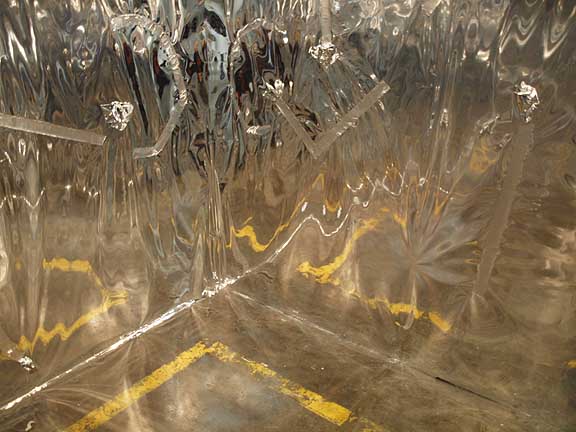
Modou Dieng's Photo Booth, 2009 from PNCA Faculty Biennial The current PNCA faculty biennial is a microcosm of the scene. Some of it is pretty interesting like Modou Dieng's photo booth and Crystal Shenk's shopping cart. Other work is banal or so academically stilted it's just a dated illustration of outmoded 1988-1996 era theory. Most falls somewhere in between, though all of it is a far cry better than the onslaught of self portraits and landscapes PNCA used to tout when I first moved here. Portland's art scene is like any good scene, you still have to hunt and peck. There are a wide variety of shows that don't completely succeed, like Fawn Krieger at TBA or the inherently hit and Everett Station lofts. Frankly, it's that variety of successes and failures that allows a critical mass of comparative experiences to take place. Back in 2002, some long-standing Portland residents contended a critical mass would never come, by 2005 the critics were an accepted truth, with 17,000+ artists working in the city, many with international renown. 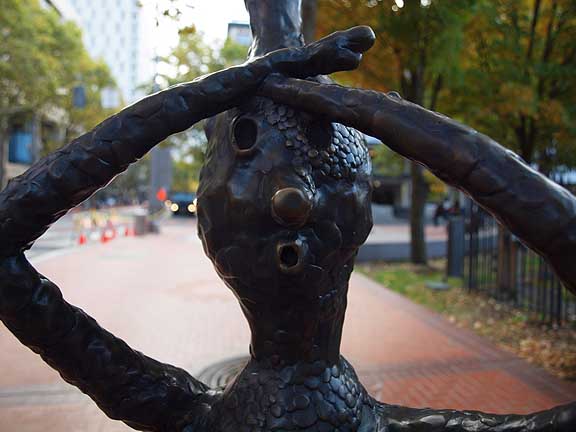 Detail of Bruce Conkle's sculpture installation Burls will be Burls, recently installed in the transit mall Portland's civic priorities regarding the support of visual art: Portland is fundamentally different from LA and New York, where the top MFA graduates are automatically placed and merchandised to fulfill market demands. Instead, the artist/critical community points out who rises to noteworthiness in Portland and it takes time. We usually give the newbies 6-12 months on the wait and see list. In Portland we place a great deal of weight on individual drive and tenacity over pedigree. Though extremely permissive of edgy projects, Portland has had problems with funding excellence or risk taking through grants and awards. Still, Portland does have them. (Disclosure: I was a finalist for RACC's top fellowship in Literature in 2008). For example, the Bonnie Bronson is a pretty conservative lifetime achievement award, which is fine, it's still an important thing to have. The problem is that there need to be more awards for artists before the lifetime achievement time. We don't have a definitive young artist's award, but we should. Perhaps a mayor's prize chosen by a rotating series of panelists? Grants and artist support: The main funding source is the Regional Arts and Culture Council (RACC). RACC's opportunities are very process driven, but they have steadily improved by increasing funding to new media projects. Still, their labels and stipulations seem archaic to most progressive artists in the scene. There are a lot of strings attached and even more labels that are ideologically annoying in such a pluralistic art world. After a meeting earlier this year, I can say RACC is aware of this issue, and it isn't the sort of thing an institution can fix quickly. RACC has been more focused on garnering greater funds and has been very successful with its Work for Art payroll matching and deduction program, which resulted in RACC disbursing its largest sum of money ever last year despite the horrible economy. Also, RACC hasn't been terribly supportive of all of the alternative spaces and independent curatorial projects. This isn't because they aren't interested, but because those shows require more flexibility and pragmatism that the RACC application process allows. Another major grant organization, The Oregon Arts Commission, runs the Oregon Cultural Trust, which was recently raided by the legislature to cover budget shortfalls. The resulting outcry got people's attention and we will see if the raid simply becomes a loan. The state's reputation as a steward of cultural money hangs in the balance. Aside from that drama, OAC's grants seem much less process and excellence driven than RACC's, though it seems less broad in scope (less installation art, for example). In fact, OAC partially funds RACC. Besides these two public sources, I'd like to see some private art awards and a suitcase fund for artists so they can travel to their shows abroad. Still, grants and awards only supplement an inherently austere artist's income. Yes, some local artists sell a decent amount of work, but the grants and awards are not generally geared towards rewarding excellence or taking chances. There are few art awards and the big ones like the Bonnie Bronson fellowship, the Contemporary Northwest Art Awards, an RACC's other top fellowships usually follow success after the fact. They don't build reputations for developing artists, they simply enhance already established notoriety. That strategy has a place but it leaves a gap. As it stands, an artist's quickest route to institutional acknowledgment in Portland is acknowledgment outside of Portland. At least the alt spaces are way ahead of larger institutions, but I'd like to see this gap bridged. Those artists who make "a living" with art often do so by showing outside of town, but what makes the community here so attractive is that it provides vital exchanges without the kinds of fiefdoms you find elsewhere. As I stated above, there just isn't that much barbed wire up here, so if you're good you will get noticed. From the top-down side things have been professionalizing and until the market crash collectors were becoming more adventurous. It will be interesting to see who buys a warehouse so they can effectively collect installation art, since PAM has not become that warehouse yet. Dealer/patron Ruth Ann Brown has stepped into the role of installation art catalyst and presented 10 stipend awards called Couture for a series of 6 week shows at NAAU. The modest $8,000 per show stipends produced 6 excellent shows: The Video Gentlemen, Jacqueline Ehlis, Jim Lommason, Laura Fritz, Vanessa Renwick and Rose McCormick, as well as 4 other less fully realized, yet still challenging experiments worth having been undertaken. As a group, those 6 best shows outstripped any similar award shows in the region at any institution or gallery, period, end of story. Only MK Guth's show at Liz Leach had similar video/installation oomph but it was only one show (understandable because Liz and the people she employs and represents have to eat). This is more the responsibility of institutions than commercial galleries, but for some reasons institutions have preferred group shows of 3 or more artists rather than taking on the risk of solo efforts. Nothing else has been even close to Couture in terms of risk-taking, noteworthiness, and anticipated excitement show after show. That said, TBA was a vast improvement this year (visual art wise) and the Contemporary Northwest Art Awards is an improvement over the pot luck Oregon biennials (if they are going to do another CNAA they will have to start soon). Noteworthiness? There are different types of noteworthiness in Portland. Very rigorous notables capable of meeting any international standards (PORT reviews some, the most critically approved ones get interviewed), young witty scenesters popular for their work's wit and social personalities, ambitious and talented "worth watching" developing artists, hard working local notables who generally aren't rigorous enough for PORT's reviews or interviews, local indie culture heros and hippy dippy community mélangists (whom PORT ignores almost entirely). Unlike some similar sized cities there is genuine confidence here because faith is placed in individuals, not money or institutions. Yet there is a lot of overdue movement on the institutional side as well. The scene has been professionalizing a great deal over the last decade. PNCA and PSU becoming more serious art schools is a huge example, but the hiring of Brian Ferriso was the bellwether. He's making a case for seriousness at the top level, while navigating difficult economic waters. I just wish they'd make a point of doing the strongest solo shows possible. I'd love a traveling retrospective by a major contemporary artist but those are very expensive. As a city, Portland is stalked by the New York Times, in part because we are a different kind of urban model. Portland isn't characterized by every man for himself competition, it's about conscientious leadership (environmental awareness, non-car transit, design as an industry, reading, opening of alt spaces). Unfortunately, I don't think Portland has fully owned up to its responsibility as a civic model to the rest of the country (not always ambitious enough about making design statements that telegraph other core values abroad). Whether or not we care to admit it, Portland IS a model city of hip human scale neighborhoods and values, green tendencies, an intense number of artists who will always outstrip resources, critical forums, great venues, and excellent non-fossil fuel modes of transportation. Artists can live and work in Portland and if they're really talented and savvy they can still have a national position. With many residencies at PNCA, OCAC, Rock's Box, Gallery Homeland and (soon to come) the Lumber Room we have begun to truly welcome artists from other cities. Then there are the great things this October with event/shows like China Design Now, Tom Cramer at Laura Russo, PORT's own Ryan Pierce's more than well-deserved debut at Liz Leach, Raphael's Woman With A Veil at PAM, and the inauguration of the Lumber Room. Still, it's the ever expanding series of Alt spaces in the city that completely sets the tone here, not the museum or galleries. A short list of influential alt spaces: Rock's Box, Worksound, Gallery Homeland, Appendix, Littlefield, Tractor, Disjecta, Igloo, Alpern Gallery. On Gallery and down south in the Eugene area Ditch projects… All are essentially artist run and pretty new. Of course we will lose some more uptown galleries to the severe recession, but we've actually gained exhibition opportunities. Those galleries who are surviving are reevaluating their rosters and in many ways updating themselves. there will probably be more of that because new artists create excitement in established gallery stables. Criticism: We don't want to be complacent. Criticism at its best is a guard against this kind of complacency. Thankfully some of what I'm seeing is good and a small portion is very very good, which is what I'm interested in. I'm particularly sensitive to how good work can be better and I'm certain the rest of PORT's staff shares this driving interest. There's always room for improvement and that is the role of criticism. Before that though let's do a little remedial course on what criticism is and isn't: What is criticism? In its simplest sense, criticism is contextualized and penetrating feedback from another's viewpoint. If it is never shared publicly it's just an opinion and because it is public it must have a compassionate element that contextualizes its position. It is also the persistence, commitment to context and trail of reviews that makes a critic "a critic" and not merely an opinionist responding to a show. A critic makes discussing the show publicly a personal priority (above and beyond friendships or even past accomplishments) - that's why all decent critics have healthy egos. It allows for the triage that comparatively calls a spade a spade. Besides the obvious armor that ego affords it can be used either as a crutch or an engine that pushes the critic to make keener and more incisive observations (same goes for artists and curators). Here are some personal rules of thumb for good criticism; 1) Criticism is a deep form of respect and ultimately the critic should care enough about the outcome of the work and health of the scene to point out both strengths and weaknesses, while understanding the work's background, etc. 2) Criticism should persistently explore the work by comparing its aims, goals, and effects with related or similar work. 3) Criticism should test the work's relevance and context to the rest of humanity (not just one scene or market). 4) Criticism should expose implications, structures, and effects (intended or otherwise) of the work, even if the artist or curator did not place special significance on those elements. After all, criticism is ultimately a way of publicly displaying a considered reaction, as if seeing something from another's eyes. That unintended but often welcomed interpretive facet of the work is usually what separates the decent from the great stuff. 5) Provocation is a form of respect. Getting under the artist's or curator's skin can be very effective in moving the discussion along. A good critic pushes buttons, a great critic pushes buttons in a way that pressures everyone to be better by instilling a culture of comparative discussion and multifaceted values, i.e. cosmopolitanism. Effective criticism is not for the thin skinned, mere social climbers, or vain opinionists, and I suspect the real trick is to pose a challenging perspective to readers that offers a benchmark in the critical landscape. Criticism must therefore always be on a high point or extreme low point. 6) Criticism should have persistence and a trail of reviews that sheds light on the critic's process (hence the reason PORT has regular contributors more than guest writers). Bad criticism: 1) Lazily repeats the artist's press release, especially when they are acquaintances or co-workers at the same art school… ugh. 2) Puts too much stock in the reputation of the artist and venue. 3) Is an excuse to make words or conveniently use the work to present some ongoing agenda. 4) Simply describes the show. That isn't criticism, it's expository writing. Personally, I never review things I have no critical compass-bearing from which to proceed (I specialize in abstract paintings, installation art [both chaotic and neat, usually not somewhere between], architecture, video and existential photography and figurative paintings). For me, criticism avoids journalistically exploiting stories to keep a job at the local paper, such as writing scathing, disingenuous articles just before major events just for the sake of tying to capture eyeballs. It just isn't a respectable practice. Also, doing hack interviews with irrelevant questions is also bad form and we expect better. One rule at PORT is to always treat the interviewee with respect (this has cost the O some high profile interview requests). PORT would never be able to interview Okwui Enwezor if we interviewed a curator like this. That's simply bad form and not fit to print. I should point out that journalism and criticism can have very different goals. Journalism can run the risk of being exploitative of good and bad news, whereas critical analysis asks questions and is invested in the asking and responding. To be fair, critics can be swayed by their invested interest in the subject. Personally, though, there have been plenty of times where artists I clearly liked haven't gotten the glowing reviews they coveted, and it has affected friendships. But so be it, that's a personal failing on their part - my closest friends and I are very candid with each other. Being a critic is a deep-seated thing and all great artists are inherently very perceptive critics (they channel it differently than a true critic does though). Donald Judd proved one could be great at both and Picasso's quips qualify as good critical art rhetoric in my book. Once again, the commitment is to better art and ideas, not to some social network. A good critic isn't in it for friendships. At its best, criticism is infinitely curious and not concerned with selling papers or subscriptions above the quality of query and response. A lot of newspapers have lost their self-touted ideals and reputation, reminding us how journalism came from tabloid-style Hearst sensationalism. Either that or they have gutted their critic's positions. The Oregonian does not have an architecture/design critic, and there are bloggers who know more about the subject than the entire newsroom's collected experience (because some bloggers are legitimate experts). This is a sad assessment and I feel the newspapers are signing their own death warrants. In a more general sense, Americans remember how the major news sources just rolled over for Bush in 9/11's wake. The public hasn't forgiven or forgotten and blogs, YouTube, and Twitter have provided a new kind of media interface of subjective, instantaneous reporting. Yet blogs, Facebook and tweets are often just as bad or worse at sensationalizing than the evening news. 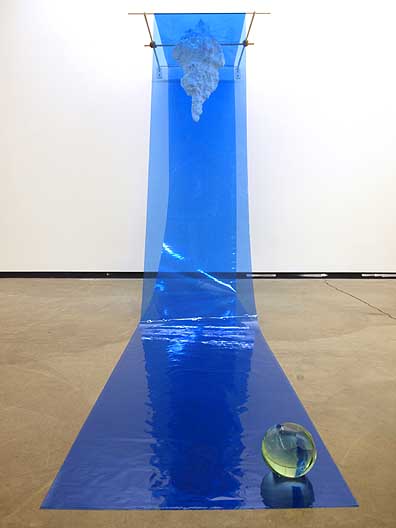 Sean Healy and Joe Thurston's collaborative project shown at Gallery Homeland's East/West in Berlin this month At PORT we aren't part of the ever sensationalized media corps. We believe the Internet can grow up. PORT's format is a critical trade journal and calendar (passionate yet sober, in depth, and completely open to disagreement unless the discussion becomes base or a personal attack). Implicitly, an honest critical response is never wholly positive or negative but a way to explore what is effective and what could be improved. Still, I consider PORT a first draft of what's developing. I think a book of our best stuff will allow us to go back and edit/improve our best pieces. Arists and critics, a purposefully tense relationship: Artists typically misunderstand criticism, and sometimes make huge mistakes by taking it as a personal affront. Even worse, many overcompensate in an attempt to push back by writing an email or blog entry. Sadly very few artists are good enough rhetoricians to go toe to toe with a seasoned critic and come off like one of those kids who cries on a ferris wheel. If you're thinking about writing a note back to a critic, especially one trying to invalidate their opinion, reconsider and take stock of the insecurities that are driving the impulse to respond (you chose art as a medium and unless you write regularly you will be at a major disadvantage). On rare occasions it is fine for an artist or curator to respond by saying, "Thanks, but I think the show is more about...." I respect that (and it is sometimes necessary), but many critics are more insecure and hold grudges so be careful. Some critics just love the paradoxes of the whole enterprise and actually care about giving useful feedback on a civic level (all PORT writers fit this description and we are doing a staff exhibition at Gallery 114 in January 2010, so you can judge how inadequate we are as artists, or not). Overall, Portland is very difficult to generalize, so I apologize for the complicated and less than perfect quality of this essay, but I thought it was important to undertake. I'll probably edit this over the next few months, making it a work in progress. What I can say is there are many strata of experience and awareness at work here because the changes have been so sudden. Some persist as if its 1988, others are working on 2028. Portland is sufficiently small to think you know everything about it and sufficiently large to prove you wrong in some case or another. I love that, and this concludes what has been a somewhat general discussion of Portland's character and PORT's response to it. Part II is a detailed critique of all aspects of the Portland art scene and will deal with artists at various points in their careers, alt spaces, Universities, the Portland Art Museum etc. Posted by Jeff Jahn on October 27, 2009 at 14:13 | Comments (2) Comments Thanks for mentioning the responsibility of artists: I also love this idea, "How about a levy on hotel rooms when travel mags continually tout Portland's arts?" Posted by: mjb This defensiveness that artists might feel towards any discussion of their work, is directly connected to their own insecurities as an artist, and is why an artist usually needs a manager. I know some great artist management people, and those are the people in the better position to make a response to a critic who may have missed something (imagine!!) Anyone can go to an art show, no matter who you are, and MISS something. There are too many issues,factors and ramifications for art work today, not to mention predispositions, historic and literary connections, sexual and emotional proclivities, and on and on. Reviewing a car is alot different, for example, unless maybe you are doing an in depth study of CURVES in automobiles. Curves make everyone see different things, in cars or in art. There is a curve, and if a critic sees the curve as ungraceful, how is the artist and curve producer going to use logic to convince the critic this is a GRACEFUL curve. The whole discussion careens off into left field at a moments notice. Maybe the critic had some bad chinese food earlier that day, and anything remotely shaped like a take-out box annoys him, he knows not why. Posted by: morgan martin Post a comment Thanks for signing in, . Now you can comment. (sign out)
(If you haven't left a comment here before, you may need to be approved by
the site owner before your comment will appear. Until then, it won't appear
on the entry. Thanks for waiting.)
|
| s p o n s o r s |
 |
 |
 |
 |
 |
 |
 |
 |
 |
 |
 |
 |
 |
 |
 |
 |

|
Site Design: Jennifer Armbrust | • | Site Development: Philippe Blanc & Katherine Bovee | |


![[TypeKey Profile Page]](http://www.portlandart.net/nav-commenters.gif)